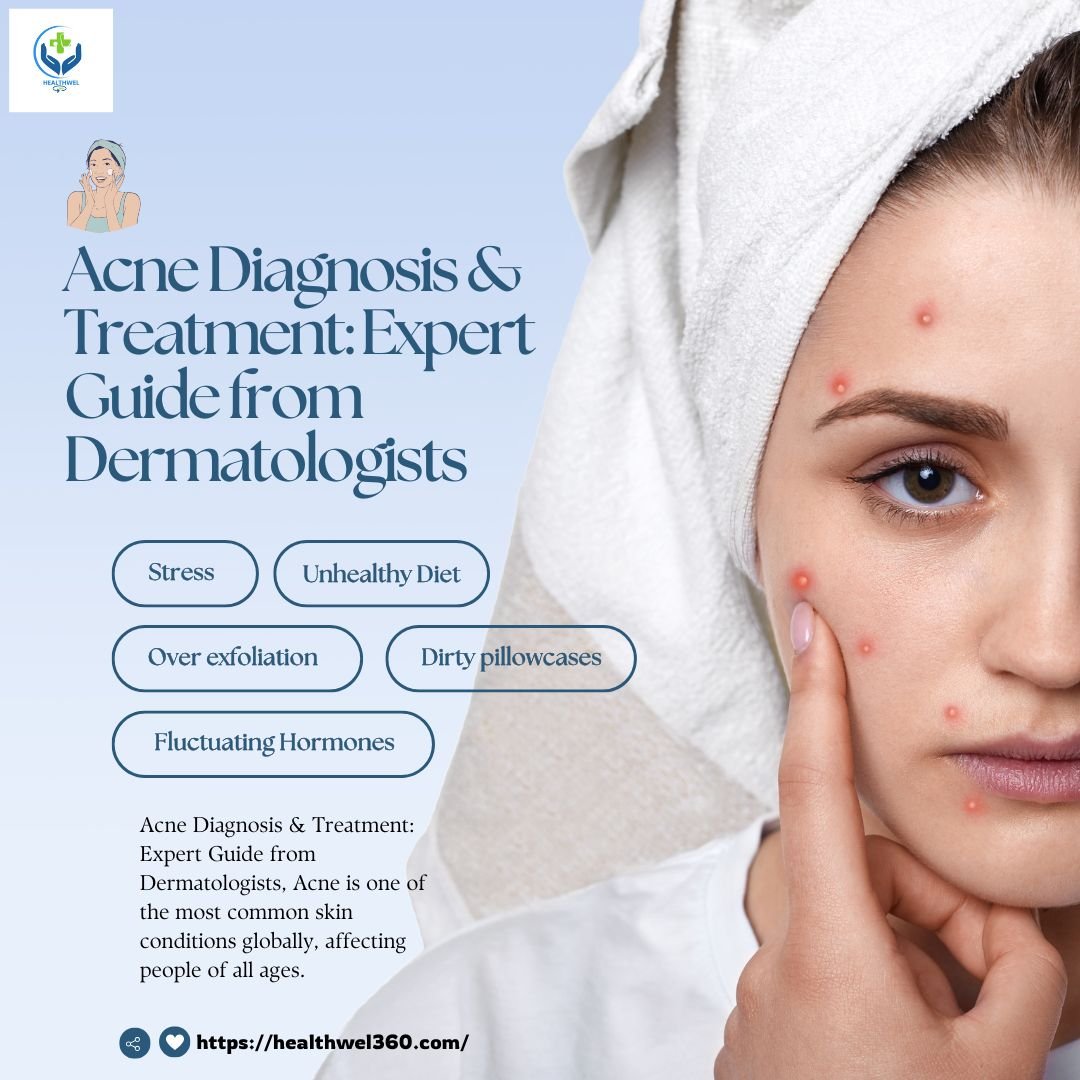Acne Diagnosis & Treatment: Expert Guide from Dermatologists, Acne is one of the most common skin conditions globally, affecting people of all ages. While occasional breakouts are frustrating, those with acne-prone skin face an ongoing battle. The good news? With the appropriate care and products, you can manage and even avoid breakouts. In this dermatologist-backed guide, we’ll break down everything you need to know.
Before diving into treatment, it’s important to understand what causes acne. Acne develops when:
- Excess oil (sebum) and dead skin cells block the pores.
- Bacteria (Cut bacterium acnes) multiply in these clogged pores
- Inflammation develops, resulting in redness, swelling, and even pus.
Hormones, stress, diet, skincare habits, and genetics all play roles in triggering acne.
Daily Skincare Routine for Acne-Prone Skin
- Cleanse Gently – Twice Daily
Use a mild, non-comedogenic cleanser that will not deplete your skin’s natural oils. Look for ingredients like:
- Salicylic acid (helps unclog pores)
- Benzoyl peroxide (kills acne-causing bacteria)
- Tea tree oil (natural antimicrobial)
👉 Avoid harsh scrubs and excessive cleaning, which can irritate the skin and worsen acne.
- Moisturize – Always
Even oily or acne-prone skin need hydration. Choose:
- Oil-free, non-comedogenic moisturizers
- The components include niacinamide, ceramides, and hyaluronic acid.
Moisturizing helps maintain your skin barrier and prevent overproduction of oil.
- Using Targeted Treatments
Topical treatments should be used consistently. Dermatologist-approved ingredients include:
- Retinoids (like adapalene or tretinoin): unclog pores and improve skin turnover
- Azelaic acid: reduces inflammation and pigment
- Benzoyl peroxide: reduces bacteria and inflammation
- Salicylic acid: exfoliates inside the pores
Start slowly (2-3 times a week) and increase as tolerated to avoid irritation.
- Sun Protection
Always wear a broad-spectrum SPF 30+ sunscreen daily. Many acne treatments increase sun sensitivity.
Choose:
- Gel or fluid formulas
- Mineral sunscreens (titanium dioxide, zinc oxide).
Lifestyle Tips That Make a Difference
- Don’t pick or pop pimples – this leads to scarring and more inflammation.
- Change pillowcases and towels regularly to reduce bacteria.
- Limit dairy and high-glycaemic foods (like sugary snacks), which may contribute to breakouts in some people.
- Manage stress – cortisol spikes can trigger acne.
When to See a Dermatologist
If over-the-counter medicines are not effective after 8-12 weeks, see a dermatologist. Prescription options may include:
- Topical or oral retinoids
- Antibiotics
- Hormonal treatment, which includes spironolactone and birth control tablets
- Isotretinoin (for severe acne)
A dermatologist can tailor a treatment plan to your skin type, acne severity, and lifestyle.
How to Treat Acne-Prone Skin: A Dermatologist’s Guide
Acne is one of the most common skin issues globally, affecting people of all ages. While occasional breakouts are frustrating, those with acne-prone skin face an ongoing battle. The good news? With the appropriate care and products, you can manage and even avoid breakouts. In this dermatologist-backed guide, we’ll break down everything you need to know.
What Causes Acne?
Before diving into treatment, it’s important to understand what causes acne. Acne develops when:
- Excess oil (sebum) and dead skin cells block the pores.
- Bacteria (Cut bacterium acnes) multiply in these clogged pores
- Inflammation develops, resulting in redness, swelling, and even pus.
Hormones, stress, diet, skincare habits, and genetics all play roles in triggering acne.
Daily Skincare Routine for Acne-Prone Skin
- Cleanse Gently – Twice Daily
Use a mild, non-comedogenic cleanser that will not deplete your skin’s natural oils. Look for ingredients like:
- Salicylic acid (helps unclog pores)
- Benzoyl peroxide (kills acne-causing bacteria)
- Tea tree oil (natural antimicrobial)
👉 Strong scrubs and excessive cleaning can irritate the skin and worsen acne.
- Moisturize – Always
Even oily or acne-prone skin need hydration. Choose:
- Oil-free, non-comedogenic moisturizers
- components such as hyaluronic acid, ceramides, and niacinamide.
Moisturizing helps maintain your skin barrier and prevent overproduction of oil.
- Using Targeted Treatments
Topical treatments should be used consistently. Dermatologist-approved ingredients include:
- Retinoids (like adapalene or tretinoin): unclog pores and improve skin turnover
- Azelaic acid: reduces inflammation and pigment
- Benzoyl peroxide: reduces bacteria and inflammation
- Salicylic acid: exfoliates inside the pores
Start slowly (2-3 times a week) and increase as tolerated to avoid irritation.
- Sun Protection
Always wear a broad-spectrum SPF 30+ sunscreen daily. Many acne treatments increase sun sensitivity.
Choose:
- Gel or fluid formulas
- Mineral sunscreens (such as zinc oxide or titanium dioxide).
Lifestyle Tips That Make a Difference
- Don’t pick or pop pimples – this leads to scarring and more inflammation.
- Change pillowcases and towels regularly to reduce bacteria.
- Eat less dairy and high-glycemic meals (such as sweet snacks), as they might cause breakouts in certain individuals.
- Manage stress – cortisol spikes can trigger acne.
When to See a Dermatologist
If over-the-counter medicines are not effective after 8-12 weeks, see a dermatologist. Prescription options may include:
- Topical or oral retinoids
- Antibiotics
- Hormonal treatment, which includes spironolactone and birth control tablets
- Isotretinoin (for severe acne)
A dermatologist can tailor a treatment plan to your skin type, acne severity, and lifestyle.
Final Thoughts
Treating acne-prone skin is a journey, not a sprint. Clearer skin is entirely possible with a regular routine, the correct products, and a little patience. Remember, your skin does not need to be “perfect” to be healthy.
